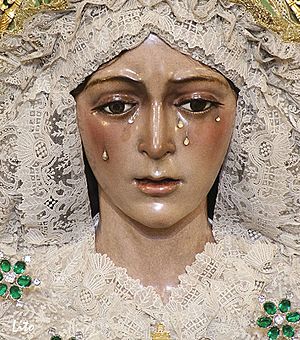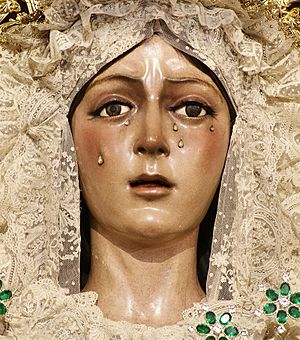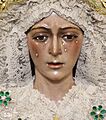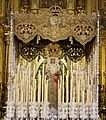Virgin of Hope of Macarena facts for kids
Quick facts for kids Virgin of Hope of Macarena |
|
|---|---|
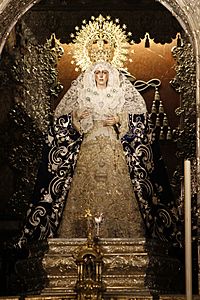 |
|
| Location | Seville, Spain |
| Date | 18 December |
| Witness | Pedro Roldán, Joselito el Gallo |
| Type | Marian art |
| Approval | 17 February 1963, during the Pontificate of Pope John XXIII |
| Shrine | Basilica of Macarena, Seville |
| Patronage | People of Seville, bullfighters, Gypsies, tailors, embroiderers and liver donors. |
| Attributes | Our Lady of Sorrows holding a handkerchief, rosary and five emerald brooches |
The Virgin of Hope of Macarena (in Spanish: Virgen de la Esperanza de Macarena de Sevilla), often called La Macarena, is a very special statue of the Blessed Virgin Mary. It is a wooden image from the 1600s. People honor it in the Basilica de la Macarena in Seville, Spain.
This statue is part of a group called Our Lady of Sorrows. These images show the sadness of the Virgin Mary during Holy Week. Many Spanish people see this statue as a national treasure. It is especially important during the time of Lent.
There is a famous story about the statue's cheek. Some say it has a discolored mark. This mark was supposedly caused by a bottle thrown at it a long time ago. People also love the five beautiful rose-Emerald brooches on her dress. A famous bullfighter named José Gómez Ortega, also known as Joselito, gave them to her. The statue wore an all-black dress only once. This was when Joselito died and was buried.
The statue's special day is celebrated in Spain on December 18. It received a special honor called a canonical coronation on May 31, 1964. This was approved by Pope John XXIII. The Virgin of Macarena is often seen as the patroness of bullfighters and Spanish Gypsies. They have a deep respect for the statue. Today, it is kept in the main altar of the Basilica of Macarena.
Contents
The Statue's History
No one knows for sure who created the statue. Many art schools argue about its true artist. A similar statue of the Virgin Mary was known to exist by 1654. It was made by an artist named Pedro Nieto. Statues like this became popular between 1670 and 1680. This was due to changes made by the Macarena religious group.
Many experts believe the statue was made by the artist Pedro Roldán. It could also have been made by someone who worked with him. Over time, the statue became damaged. It was fixed in March 1881 by Emilio Pizzaro de la Cruz. He made new arms and hands for it. It was repaired again in 1883.
In the early 1900s, a famous embroiderer named Juan Manuel Rodríguez Ojeda worked on the statue. He was a member of the Macarena brotherhood. He made a beautiful mantle (a type of cloak) for the statue. This mantle was made with gold embroidery and gold-plated metal. People called it a "mesh cape."
By 1908, a red velvet canopy was added. This helped protect the statue from bad weather. It was fixed again in 1964. The statue's crowns and other items were changed many times. This happened in 1938, 1953, and 1963.
A new cape was made in 1930. It was special because it used emerald green color along with gold. King Alfonso XIII of Spain helped make the statue more famous. He issued a royal document about it in 1904. On April 11 of that same year, Cardinal Eustaquio Ilundáin y Esteban blessed the statue and its new cape.
There is a story about a person who threw a wine bottle at the statue. This happened sometime before the 1950s. The next year, this person helped carry the statue in a procession. This was to show they were sorry for what they did.
The statue received a special honor on March 27, 1913. Cardinal Enrique Almaraz y Santos performed a canonical coronation. He also added the five emerald brooches given by the bullfighter El Gallo. The Archbishop of Seville repeated a similar coronation in 1964.
Protecting the Statue During War
During the Spanish Civil War, some people tried to destroy religious items. On July 18, 1936, they entered the Macarena church. People quickly hid other statues to keep them safe. They put them under a storage area beneath the church steps. When statues are in danger from war, they are often secretly buried.
The Macarena statue was carefully taken apart. Its clothes were removed. It was then secretly taken to a member of the Confraternity (the religious group) for safekeeping. Because of the war, the confraternity had to move. They went to the Church of the Annunciation.
About the Statue
The statue was made by an unknown artist around 1680. It is 175 centimeters tall. It is a special type of statue called a mannequin image. It is made from pine wood and cypress.
The statue has a sad face with glass tears. It also has a human wig and looks downwards. Its mouth is open, showing a tongue and teeth. The statue holds a mourning handkerchief in its right hand. It holds a Rosary in its left hand. It also has a gold medal from the city's mayor, given in 1971.
Special Coronation Ceremony
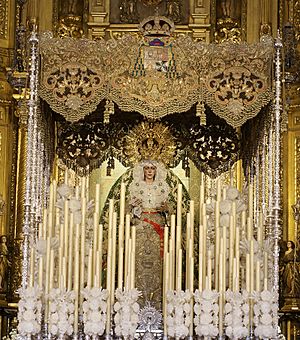
In Spain, very popular religious statues often receive a special ceremony. This is called a canonical coronation, approved by the Pope. On December 20, 1962, the Macarena Confraternity asked Pope John XXIII for this honor.
On February 17, 1963, the Pope agreed. Cardinal Paolo Marella helped arrange it. The statue was moved on May 27, 1964, to the Cathedral of Seville. There was a three-day celebration and a special Holy Mass. A very important Mass was held, and the head of state at the time, Francisco Franco, attended.
Making copies of this statue is very difficult and costly. So, statues of this type are rare. However, other approved copies of this specific statue have been made. They are found in other Catholic countries. These include Colombia (7), Brazil (2), Uruguay (1), Venezuela (4), Peru (2), and the Philippines (1).
Images for kids
See also
 In Spanish: Esperanza Macarena de Sevilla para niños
In Spanish: Esperanza Macarena de Sevilla para niños


